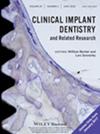Comparison of Different Frameworks and Implant Angulations in All-On-Four and Six Concepts: A Finite Element Analysis
Abstract
Objectives
The study aimed to compare the biomechanical behaviors in the all-on-four and all-on-six concept prostheses of different framework materials (cobalt-chromium Co-Cr, titanium Ti, and polyetheretherketone PEEK) and posterior implant angulation in the completely edentulous maxilla.
Material and Methods
According to the all-on-four and all-on-six concepts, four different three-dimensional (3D) models were created for the completely edentulous maxilla. The posterior implants were positioned in the premolar region, 30° and 45° angled distally. The frameworks were designed and simulated using the material properties of Co-Cr, Ti, and PEEK. A load of 200 N in the palatobuccal direction was applied to the occlusal surface of the posterior implants bilaterally. The von Mises, maximum, and minimum principal stresses were obtained.
Results
In both concepts, the stress values of the PEEK framework were significantly higher than the stress values of Co-Cr and Ti frameworks in terms of implant, cortical bone, and abutment. The highest von Mises value between frameworks was determined in the Co-Cr framework in the all-on-six concept. Implants with a 45° angle in the posterior showed higher stress values than implants with a 30° angle.
Conclusion
As the number of implants increased, the stress on the implant and cortical bone decreased, while it increased on the abutment and prosthetic framework. The increase in the tilt angle of the posterior implants was directly proportional to the rise in stress concentration.

 求助内容:
求助内容: 应助结果提醒方式:
应助结果提醒方式:


